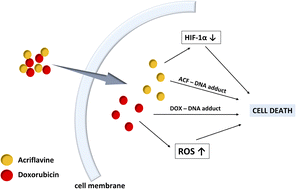Is acriflavine an efficient co-drug in chemotherapy?
Abstract
Cancer is a global health problem being the second worldwide cause of deaths right after cardiovascular diseases. The main methods of cancer treatment involve surgery, radiation and chemotherapy with an emphasis on the latter. Thus development of nanochemistry and nanomedicine in a search for more effective and safer cancer treatment is an important area of current research. Below, we present interaction of doxorubicin and acriflavine and the cytotoxicity of these drug nano-complexes towards cervical cancer (HeLa) cells. Experimental results obtained from NMR measurements and fluorescence spectroscopy show that the drugs' interaction was due to van der Waals forces, formation of hydrogen bonds and π–π stacking. Quantum molecular simulations confirmed the experimental results with regard to existing π–π stacking. Additionally it was shown that, at the level of theory applied (DFT, triple zeta basis set), the stacking interactions comprise the most preferable interactions (the lowest ΔG ca. −12 kcal mol−1) both between the molecules forming the acriflavine system and between the other component – another drug (doxorubicin) dimer. Biological tests performed on HeLa cells showed high cytotoxicity of the complexes, comparable to free drugs (ACF and DOX), both after 24 and 48 hours of incubation. For non-cancerous cells, a statistically significant difference in the cytotoxicity of drugs and complexes was observed in the case of a short incubation period. The results of the uptake study showed significantly more efficient cellular uptake of acriflavine than doxorubicin, whether administered alone or in combination with an anthracycline. The mechanism determining the selective uptake of acriflavine and ACF : DOX complexes towards non-cancer and cancer cells should be better understood in the future, as it may be of key importance in the design of complexes with toxic anti-cancer drugs.



 Please wait while we load your content...
Please wait while we load your content...